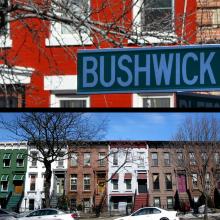Update (2020): The Bushwiki was originally developed as a Wikispaces site. Wikispaces ceased operations in 2018, and as of March, 2020, all of the basic building data from the Bushwiki has been imported into Novelty Theater. The original data, including building descriptions and articles can be found here. We are (slowly) working on bringing all of that information into Novelty Theater. The description below is from the original Bushwiki site, lightly edited.
Bushwiki entries in Novelty Theater are authored by user "bushwiki". Original research for this project was conducted by Laurel Albrecht, Kelly Carroll, Heather Hartshorn, Matthew Kuhnert, Alison LaFever, Esther Mittelman, Dianne Pierce O’Brien, Asuka Ogawa, Lauren Perez, Sarah Rosenblatt, Michelle Taylor. Ward Dennis was the faculty advisor for the studio.
The Bushwiki is a pool of resources and information on the historic Bushwick Avenue community in Brooklyn, NY. It was created by a group of graduate students in the Columbia University Historic Preservation 2011 Advanced Studio with the goal of highlighting Bushwick’s history and community. This site is designed to be maintained and continued by those interested in understanding and preserving Bushwick’s history. We hope the community will use, share, and add to this collection. Below, you will find links to the different properties and types of information we researched–we have collected information on the community’s historic fabric, as well as community resources that will be useful in creating a preservation plan.
The Objective
Bushwick Avenue is a distinctive residential enclave within the City of New York. Our study area is Bushwick Avenue between Flushing Avenue and Eldert Street and some selected sidestreets, which we have included in our proposed historic districts. In the context of broader redevelopment strategies, an enhanced and socially-inclusive historic preservation plan can help identify and foster awareness of heritage resources, connecting residents of this diverse area to the urban landscape and to one another. Our study of the Bushwick Avenue corridor suggests there is an enormous potential for the implementation of historic preservation practices and future community revitalization initiatives. Not only will this provide Bushwick with the tools to retain its unique and distinctive character, as well as provide a framework for responsible growth, it will also help connect residents to the history and meaning of place in ways that can enrich and empower them. We recognize that each community has a unique culture and history–this is about giving the Bushwick community the tools and resources to control and shape the future of their community so that its historic and cultural resources are not lost.
The Neighborhood
The Bushwick study area is defined by:
-
A mix of building types
-
Industrial/manufacturing buildings at the northern area of the study area
-
Relatively low-scale buildings, especially unique along a wide avenue
-
64.4% of buildings built between 1880-1915; lends a strong late-19th century character
-
A historically diverse population in terms of socioeconomic status and ethnicity, which continues today
-
The legacy of the 1977 New York City Blackout and the community efforts in the aftermath
Link to Final Report:
http://www.arch.columbia.edu/files/gsapp/imceshared/Bushwick_Avenue_Preservation_Plan_2011.pdf
